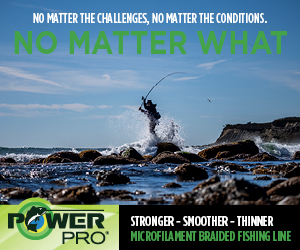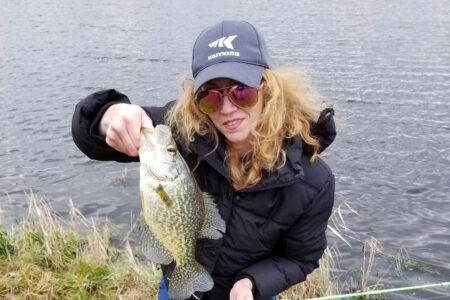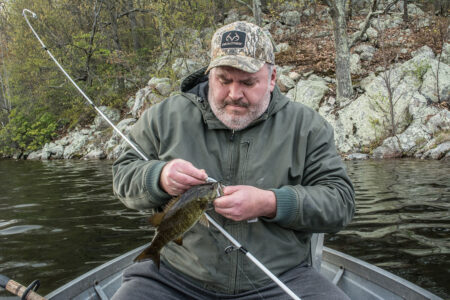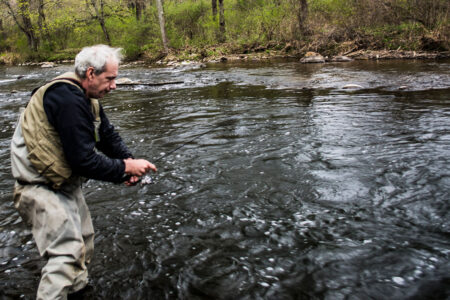
From Mendham to Iron Bound, the 80-mile Passaic River is a perfect place to begin an adventure.
Over the last several years, my passion for kayak fishing has grown immensely as I have sought a wider variety of fish and in various types of waterways throughout New Jersey. Anything from snakeheads in the swamps of South Jersey and muskies in cold fall lakes, as well as coastal stripers.
But my favorite predator fish to chase has to be the New Jersey northern pike; catching these ferocious toothy critters is nothing short of exciting. And while the challenge of fishing from a kayak has consistently compelled me to come up with new ideas and twists, my latest adventure going at pike on the fly rod sent me online for some winter research.
Gearing Up
After watching several YouTube videos I concluded that chasing Jersey river gators on the fly would require a 9-foot, 8-weight fly-rod, which I found on eBay. Due to my history of breaking rods, I decided not to make a heavy investment with the first go-around. The set-up arrived days later with the reel pre-spooled with line I just assumed it would work in conjunction with the over-sized tandem flies I had also purchased. Boy was I ever wrong.
Down at the river for a March test I scored a big “F” as I couldn’t cast this thing at all. Everything felt all out of sync weight-wise on that cold day along the Passaic River. Having fly fished since the age of 10, I’m no novice, nor do I consider myself a fly fishing expert either. However, nothing felt right; I couldn’t roll-cast, nor could I get the fly to lay out properly on a simple over-hand cast.
That Monday on my way home from work, I stopped by to see Jim Holland at Shannon’s Fly and Tackle Shop in Califon. I brought my rod into the shop and explained my casting dilemma. “I know what you need, but let’s give this a shot first,” Jim said while removing the old line from the reel. After adding a new spool of line, we walked out into the cold, night time air for a few practice casts down Main Street.
As I made several casts, Jim watched and offered advice, explaining how the weight ratio of the new line with the size of the fly was better, but still a bit off. He said in order to cast this size of a fly effectively, I needed a weight-forward line, and with that we were back inside the shop ordering Touch Pike/Musky Line made by RIO from the catalog. A week later, I was pleasantly surprised to see Jim easily casting a good 25 yards with my newly spooled fly reel, paring the line with RIO 15-pound Toothy Critter Hand-Tied Leader.
My rod and reel combo of choice was a Redington Pursuit 890-4 9-foot 8-weight freshwater fly rod and reel for just under $200. Coupled with the weight-forward line and tooth-proof leader, it was more than sufficient for the task at hand. I wouldn’t recommend using a rod shorter than 9 feet, especially in the river. You won’t be casting far, although you will need the height to get good casting momentum for working this type of weighted line.
I’m fishing a Perception Sport sit-on-top (SOT) kayak, an 11.5-footer; I have both sit-in and SOT kayaks but prefer the latter since it’s more open with a slightly higher sitting style. I think sitting on top is more comfortable seating-wise over the course of the day, and since I’ve had three major back surgeries, seating comfort really is certainly a priority in my case. In addition to standard gear one would usually expect from kayak fishing, when it comes to the razor-like teeth of a northern, make sure to add a good set of fish grips as well.
Adventure Begins
The quest to catch a northern pike while fly fishing from a kayak took me 58 miles from home to the Passaic River. The water in the Passaic is always murky, even on its clearest day anytime I’ve ever fished it, but those murky, dark waters coupled with blown down trees and brush provide the ideal habitat for these predator fish. On the day I arrived, the water levels were a bit low, but the discolored water had pike written all over it. For the first 15 minutes or so I worked around some submerged brush with a tandem chartreuse “Pike Bunny-Tail” fly; on the fifth cast while retrieving the submerged fly to literally within 2 feet of the kayak a long, dark silhouette swiped and missed! My heart was pounding as I smiled and thought to myself, “Holy cow, this is going to work!”
I continued to slowly work my way upstream as my plan was to go so far up, then drift back nice and quietly working around the structure while targeting the pockets for casts. The next pocket created sort of a little back-eddy among the partially submerged timber. I began making short casts as there wasn’t much room to maneuver the kayak and cast. In a matter of moments, I saw a flash just as I began to lift the fly out of the water and quickly dropped it back to a 14-inch crappie, a huge slabside even given the size of the fly I was using.
At the next pool I wedged the kayak between some partially submerged trees to hold against the current. As I laid a cast across the short pool, immediately I saw the “wake” speeding towards the fly where it just hit the water. The pike grabbed the fly and dove into the depths as I quickly retrieved the line and reeled back my rod to set the hook. The rod bent all the way to the water as I fought, but in a matter of minutes, he was off. I sat there staring at the water and shaking my head in disbelief. This definitely wasn’t like fly-fishing for trout on the South Branch in Califon. This was a totally different game, from working the fly to the hook-set.
As I began my drift downstream, my strategy was to work the pools and pockets quickly and as precisely as possible given that the current would determine how long I could spend in each spot. I drifted into a sort of dammed up portion where the current veered to the right leaving a nice slow pool to my left to work. As I worked the Bunny-Tail cross-current of the pool a familiar, long, dark figure chased the fly, then sort of sucked it in. I set the hook violently as the northern momentarily thrashed on top of the water. After a couple of twists and turns I had netted my first northern pike on a fly. Not a monster by any means, as it taped out at 25-1/2 inches, but I was ecstatic.
A Fish Has Landed
Over the next few hours I landed two more decent northerns and then ran into a couple guys fishing out of a canoe. As I got closer, I yelled over, “You guys keep fishing the opening I’ll go way over to the right and stay out of your way.” One guy had recognized me from articles, so I paddled up to the pair, we shook hands, introduced one another and they gladly took a picture of me with one of the pike I had caught.
“Boy now that’s different, going after northerns with a fly-rod, never saw anybody try that yet,” one said with laugh. A couple of really decent guys; we chit-chatted a bit more, then went our ways. As the afternoon continued to pass along, it started to cloud up, like there might’ve been a storm blowing in. By this time I was several miles downriver from where I had parked. I snickered to myself thinking what my girlfriend Sharon always says, “Text me so I know where you are.” This has sort of became the norm after I suffered a massive heart attack a couple of years back. I typically respond, “You’d never find me in some of the places I end up. Best bet would be to watch where the buzzards are circling!”
Paddling down into for me what was uncharted territory I came upon a still, slow-moving deep pool. Again wedging myself between two small, low-lying brush piles, I began to work my fly by varying the presentations slightly with each cast, trying to entice a nice toothy critter. On my fourth cast, the water erupted and boiled as a large northern hit the fly like a train! Quickly I reeled back, snapped up the line while at the same time setting the hook. The strong esox fought gallantly as my rod was bent almost to the water. I battled the northern for what seemed like 15 minutes, missing him twice with the net.
The heavy river monster dove under the kayak, thrashing out of the water on the other side at one. I played the big pike out until he was exhausted and I could eventually scoop him into my net, a 34-incher that weighed just shy of 9 pounds. Suffice to say, my mission was accomplished.
Just keep in mind all of the things going on at one time in this type of fishing situation presented by the Passaic River (current, paddling the kayak, working a fly-rod and maneuvering around river debris). Think safety, and a word of caution to beginner kayakers about trying this particular type of fishing.
Follow New Jersey outdoorsman Ken Beam at AdventuresWithKen.com.




